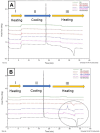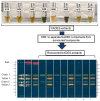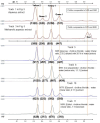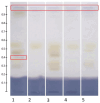Natural Deep Eutectic Solvents (NADESs) for the Extraction of Bioactive Compounds from Quinoa (Chenopodium quinoa Willd.) Leaves: A Semi-Quantitative Analysis Using High Performance Thin-Layer Chromatography
- PMID: 40572583
- PMCID: PMC12195850
- DOI: 10.3390/molecules30122620
Natural Deep Eutectic Solvents (NADESs) for the Extraction of Bioactive Compounds from Quinoa (Chenopodium quinoa Willd.) Leaves: A Semi-Quantitative Analysis Using High Performance Thin-Layer Chromatography
Abstract
Natural deep eutectic solvents (NADESs) have emerged as a promising eco-friendly alternative to petrochemicals for extracting plant metabolites. Considering that the demand for sustainable "green" ingredients for industrial applications is growing, those solvents are purported to develop extracts with interesting phytochemical fingerprints and biological activities. Given the interest in flavonoids from Chenopodium quinoa Willd. leaves, an efficient "green" extraction method was developed by investigating eight NADESs with defined molar ratios, i.e., malic acid-choline chloride (chcl)-water (w) (1:1:2, N1), chcl-glucose-w (5:2:5, N2), proline-malic acid-w (1:1:3, N3), glucose-fructose-sucrose-w (1:1:1:11, N4), 1,2-propanediol-chcl-w (1:1:1, N5), lactic acid-glucose-w (5:1:3, N6), glycerol-chcl-w (2:1:1, N7), and xylitol-chcl-w (1:2:3, N8). Rheological measurements of all NADESs confirmed their pseudoplastic behaviors. To improve the extraction processes, differential scanning calorimetry (DSC) allowed us to determine the maximum amount of water that could be added to the most stable NADES (N1, N2, N3, and N4; 17.5%, 20%, 10%, and 10% w/w, respectively) to lower their viscosities without disturbing their eutectic environments. The phytochemical compositions of NADES extracts were analyzed using high-performance thin-layer chromatography (HPTLC), and their free radical scavenging and α-amylase inhibitory properties were assessed using HPTLC-bioautography. N2, diluted with 20% of water, and N7 presented the best potential for replacing methanol for an eco-friendly extraction of flavonoids, radical scavengers, and α-amylase inhibitors from quinoa leaves. Their biological properties, combined with a good understanding of both thermal behavior and viscosity, make the obtained quinoa leaf NADES extracts good candidates for direct incorporation in nutraceutical formulations.
Keywords: Amaranthaceae; antioxidant activity; eco-extraction; high-performance thin layer chromatography-bioautography; natural deep eutectic solvents.
Conflict of interest statement
The authors declare no conflicts of interest.
Figures









Similar articles
-
Eco-friendly extraction of polysaccharides from Moringa oleifera Lam. leaves using COSMO-RS screened natural deep eutectic solvents.Food Res Int. 2025 Oct;217:116859. doi: 10.1016/j.foodres.2025.116859. Epub 2025 Jun 13. Food Res Int. 2025. PMID: 40597557
-
Green Approaches for Preparation of Natural Deep Eutectic Solvents for Determination of As, Cd, and Pb in Plant Samples by ICP-MS.ACS Omega. 2025 Jun 11;10(24):26118-26128. doi: 10.1021/acsomega.5c03345. eCollection 2025 Jun 24. ACS Omega. 2025. PMID: 40584316 Free PMC article.
-
Green Extraction of Antioxidant Polyphenols from Strawberry Tree (Arbutus unedo L. ) Fruits and Leaves: Application of Deep Eutectic Solvents in the Ultrasound-Assisted Extraction.An Acad Bras Cienc. 2025 Jul 14;97(3):e20241084. doi: 10.1590/0001-3765202520241084. eCollection 2025. An Acad Bras Cienc. 2025. PMID: 40667928
-
The Rise of Green Solvents: Application and Efficiency of Deep Eutectic Solvents in the Extraction of Flavonoids.J Food Sci. 2025 Jul;90(7):e70381. doi: 10.1111/1750-3841.70381. J Food Sci. 2025. PMID: 40610205 Review.
-
A rapid and systematic review of the clinical effectiveness and cost-effectiveness of topotecan for ovarian cancer.Health Technol Assess. 2001;5(28):1-110. doi: 10.3310/hta5280. Health Technol Assess. 2001. PMID: 11701100
References
-
- Castro V.I.B., Mano F., Reis R.L., Paiva A., Duarte A.R.C. Synthesis and physical and thermodynamic properties of lactic acid and malic acid-based natural deep eutectic solvents. J. Chem. Eng. Data. 2018;63:2548–2556. doi: 10.1021/acs.jced.7b01037. - DOI
-
- Gullón P., Gullón B., Romaní A., Rocchetti G., Lorenzo J.M. Smart advanced solvents for bioactive compounds recovery from agri-food by-products: A review. Trends Food Sci. Technol. 2020;101:182–197. doi: 10.1016/j.tifs.2020.05.007. - DOI
-
- Savi L.K., Dias M.C.G.C., Carpine D., Waszczynskyj N., Ribani R.H., Haminiuk C.W.I. Natural deep eutectic solvents (NADES) based on citric acid and sucrose as a potential green technology: A comprehensive study of water inclusion and its effect on thermal, physical and rheological properties. Int. J. Food Sci. Technol. 2018;54:898–907. doi: 10.1111/ijfs.14013. - DOI
-
- Deng Y., Zhou J., Qu J., Wang B., Xu X., Zhao C. Deep Eutectic Solvents and Wall-Breaking Technique: A New Frontier in the Extraction of Oleuropein and Flavonoids from Olive Leaves with Superior Antioxidant and Antitumor Potential. Molecules. 2025;30:1150. doi: 10.3390/molecules30051150. - DOI - PMC - PubMed
-
- Alam M.A., Muhammad G., Khan M.N., Mofijur M., Lv Y., Xiong W., Xu J. Choline chloride-based deep eutectic solvents as green extractants for the isolation of phenolic compounds from biomass. J. Clean. Prod. 2021;309:127445. doi: 10.1016/j.jclepro.2021.127445. - DOI
MeSH terms
Substances
Grants and funding
LinkOut - more resources
Full Text Sources

